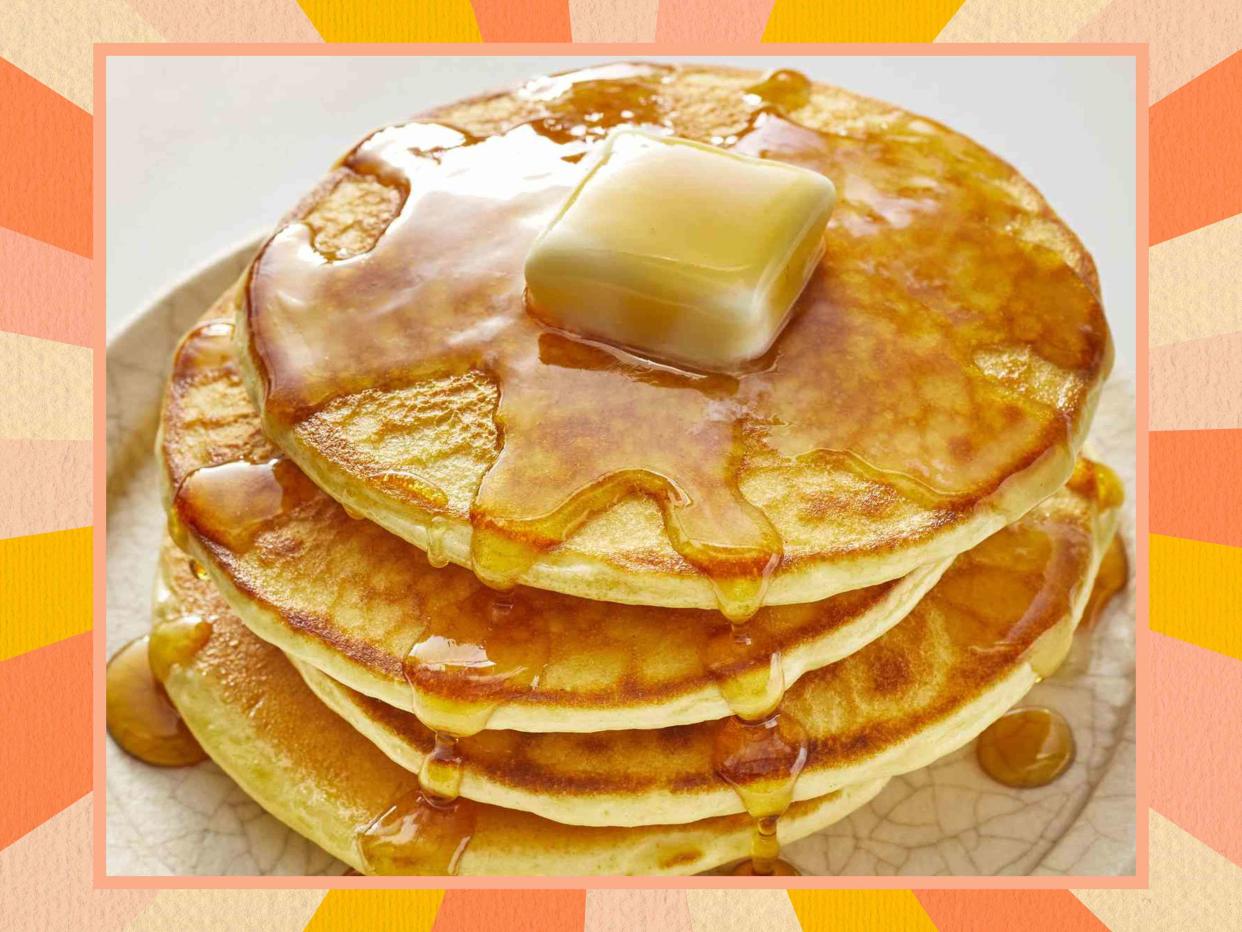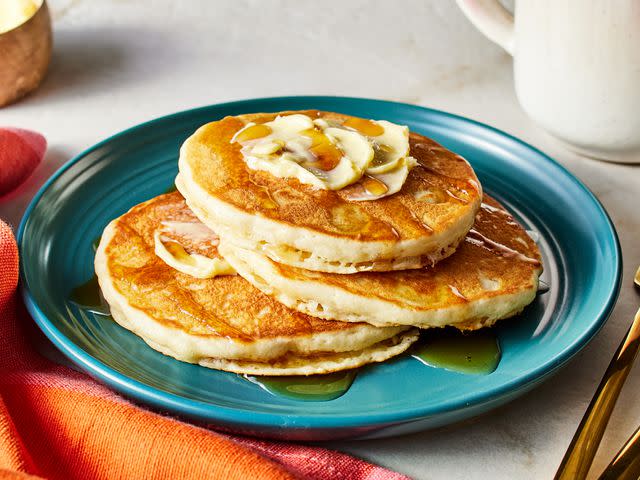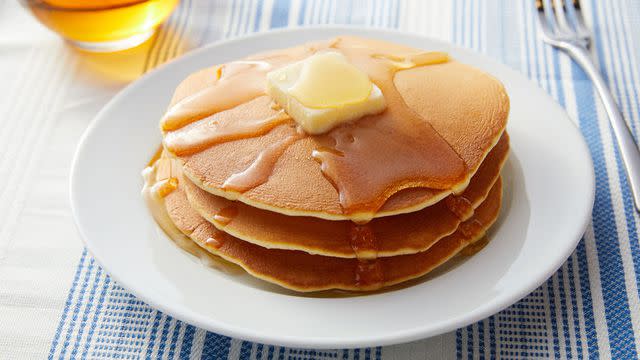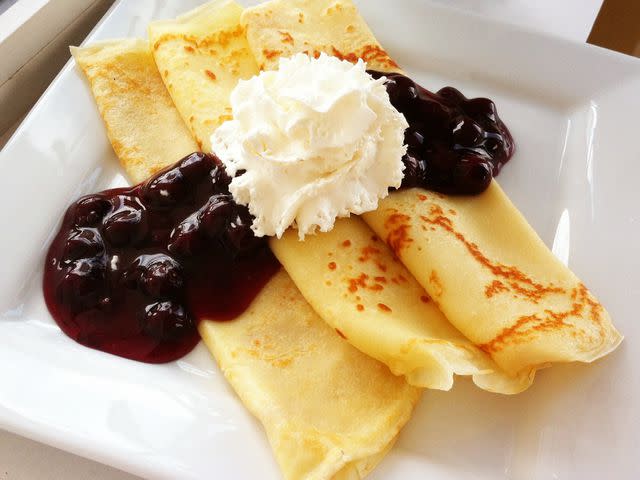Who Invented Pancakes—And Where Did They Come From?

DotDash Meredith Food Studios
It’s Saturday morning. The house is filled with the smell of butter, maple syrup, and the unmistakable scent of batter lightly cooking to a golden brown: It’s pancake day. An American classic, pancakes are a staple of weekend breakfast. Whether you like them studded with blueberries or chocolate chips, topped with syrup or jam, or made with gluten-free or whole wheat flour, pancakes are endlessly customizable—and the perfect pancake is out there for everyone.
Besides their melt-in-your-mouth texture, pancakes are so popular because they rely on everyday pantry staples like flour, butter, and eggs that most people already have on hand. The batter comes together quickly and you can go from the pantry to the plate in a flash.
In 1931, Bisquick made pancakes even easier, and now, many American households use pre-made mixes to have a golden brown stack of pancakes on the breakfast table, even on weekday mornings.

When Were Pancakes Invented?
Pancakes, like many foods that have been popular for so long, have existed in many iterations across history. Technically, the ancient Greeks were making a type of pancake from wheat, honey, and sour milk around 500 B.C.E., according to Meals and Recipes from Ancient Greece.
Recent tests on Stone Age tools suggest that our ancestors were grinding grains, mixing them with water, and cooking them on rocks up to 30,000 years ago, reports National Geographic (though you might need a lot of syrup to make that type of pancake, or rather rock-cake, taste good). All over the world, every culture has been mixing grain with liquid and cooking it into some form of pancake pretty much since early humans learned to cook. Before European colonization of the Americas, many indigenous people used corn to make versions of pancakes that preceded wheat flour pancakes, and many indigenous communities across the United States continue to make iterations of this dish today. Though wheat pancakes are more popular today, you can still see the influence of early corn pancakes in the many varieties of corn cakes in the American South.
American-style pancakes, as we think of them today, probably came about in the 1700s. Dutch settlers brought their version of pancakes to America, where they quickly became in demand. The ingredients were cheap and the recipe was easy to make in large batches to feed a family, so they quickly caught on. Unlike baked goods, pancakes were made quickly on the stove or over an open flame and didn’t require special bakeware. In the 1870s, the term “flapjack” entered the American vocabulary to describe this type of American-style pancake, and their popularity grew. During this time, the first American diners were starting to pop up. As this restaurant model grew, so did the popularity of pancakes, cementing the classic diner-style buttermilk pancake we all love today.

Dotdash Meredith Food Studios
Who Invented Pancakes?
One of the earliest cookbooks we have a record of, De re Coquinaria, was written by an Ancient Roman cook named Apicius in the fifth century C.E. This book has a recipe for something that could be considered a pancake if you were extremely generous with the term. However, like many dishes, it’s difficult to pinpoint exactly who invented it and when.
Just because this is the oldest book we have a record of doesn’t mean it’s the first occurrence of pancakes. Some versions of proto-pancakes have always existed in our culinary history as a species, so it's tough to nail down who exactly invented them, especially since the recipe has evolved so much over time. So, who invented pancakes? Pancakes are the product of thousands of years of collective culinary evolution, and a delicious one at that.

Pancakes Around the World
In the United States, when we hear “pancakes,” we think of fluffy, sweet versions of pancakes topped with butter and maple syrup. However, slightly expanding the definition of pancakes can include many other delicious dishes from other cuisines. While not usually referred to as “pancakes,” many cultures make some yummy pancake-adjacent foods. Pancakes can really mean any circular type of food, sweet or savory, wheat flour, or other ingredients. The sky’s the limit!

Crepes: In France, crepes are made similar to American pancake batter—but with lots of milk and without chemical leaveners like baking powder. The result is an ultra-thin circle of batter that can be filled with sweet or savory fillings. Sweet crepes feature fillings like Nutella, fresh fruit, jam, and more. Savory versions are often made with buckwheat flour and are stuffed with ham, cheese, eggs, blister tomatoes, or greens.
Blini: Speaking of buckwheat flour, east of France, in several Eastern European countries, especially Russia, you’ll run into blini. These little silver dollar-sized pancakes are usually leavened with yeast and use buckwheat flour for a nutty flavor. Blini are typical vehicles for caviar, but other fish, like smoked salmon, are also common toppings.
Æbleskiver: Head a bit farther north and back into Western Europe, and you’ll stumble upon Æbleskiver in Denmark. These spherical pancake balls are made in a special pan to give them their golf ball shape. The batter is remarkably similar to American pancake batter but often includes more butter and lemon zest. Æbleskiver are usually stuffed or dipped in strawberry or currant jam, and more traditional recipes include a thick applesauce filling.
Bánh xèo: In Vietnam, you can’t miss Bánh xèo, a savory stuffed pancake that’s a super popular street food. The batter is made from rice flour; its thin consistency gives it a crispy, almost lacey texture. It’s often folded in half like an omelet and stuffed with various fillings like lettuce, handfuls of fresh herbs, pickled veggies, and Chinese sausage, all dipped in a sweet fish sauce and lime dipping sauce.
Cachapas: Further south in Venezuela, you’ll be lucky to be treated to cachapas, a corn-based griddlecake. A mixture of ground corn flour and kernels of corn gives cachapas a wonderfully diverse texture. Eat them plain, warm from the comal, or with a handmade, fresh white cheese similar in texture to fresh mozzarella. If you like southern corn cakes or Johnny cakes, you’ll love cachapas.
Read the original article on All Recipes.






